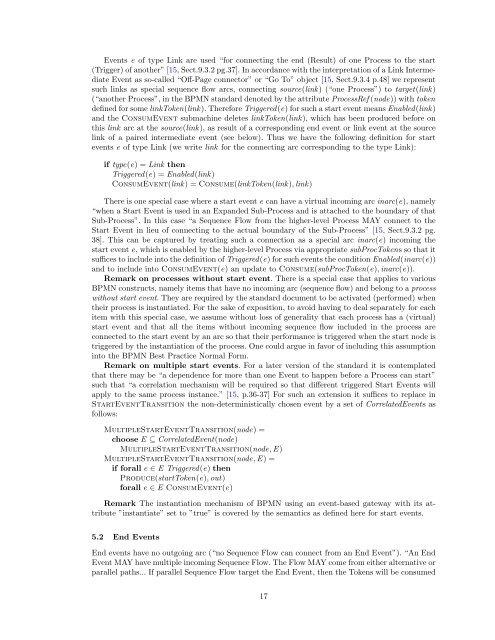BPMN and Beyond Business process modelling notation, workflow ...
BPMN and Beyond Business process modelling notation, workflow ...
BPMN and Beyond Business process modelling notation, workflow ...
Create successful ePaper yourself
Turn your PDF publications into a flip-book with our unique Google optimized e-Paper software.
Events e of type Link are used “for connecting the end (Result) of one Process to the start<br />
(Trigger) of another” [15, Sect.9.3.2 pg.37]. In accordance with the interpretation of a Link Intermediate<br />
Event as so-called “Off-Page connector” or “Go To” object [15, Sect.9.3.4 p.48] we represent<br />
such links as special sequence flow arcs, connecting source(link) (“one Process”) to target(link)<br />
(“another Process”, in the <strong>BPMN</strong> st<strong>and</strong>ard denoted by the attribute ProcessRef (node)) with token<br />
defined for some linkToken(link). Therefore Triggered(e) for such a start event means Enabled(link)<br />
<strong>and</strong> the ConsumEvent submachine deletes linkToken(link), which has been produced before on<br />
this link arc at the source(link), as result of a corresponding end event or link event at the source<br />
link of a paired intermediate event (see below). Thus we have the following definition for start<br />
events e of type Link (we write link for the connecting arc corresponding to the type Link):<br />
if type(e) = Link then<br />
Triggered(e) = Enabled(link)<br />
ConsumEvent(link) = Consume(linkToken(link), link)<br />
There is one special case where a start event e can have a virtual incoming arc inarc(e), namely<br />
“when a Start Event is used in an Exp<strong>and</strong>ed Sub-Process <strong>and</strong> is attached to the boundary of that<br />
Sub-Process”. In this case “a Sequence Flow from the higher-level Process MAY connect to the<br />
Start Event in lieu of connecting to the actual boundary of the Sub-Process” [15, Sect.9.3.2 pg.<br />
38]. This can be captured by treating such a connection as a special arc inarc(e) incoming the<br />
start event e, which is enabled by the higher-level Process via appropriate subProcTokens so that it<br />
suffices to include into the definition of Triggered(e) for such events the condition Enabled(inarc(e))<br />
<strong>and</strong> to include into ConsumEvent(e) an update to Consume(subProcToken(e), inarc(e)).<br />
Remark on <strong>process</strong>es without start event. There is a special case that applies to various<br />
<strong>BPMN</strong> constructs, namely items that have no incoming arc (sequence flow) <strong>and</strong> belong to a <strong>process</strong><br />
without start event. They are required by the st<strong>and</strong>ard document to be activated (performed) when<br />
their <strong>process</strong> is instantiated. For the sake of exposition, to avoid having to deal separately for each<br />
item with this special case, we assume without loss of generality that each <strong>process</strong> has a (virtual)<br />
start event <strong>and</strong> that all the items without incoming sequence flow included in the <strong>process</strong> are<br />
connected to the start event by an arc so that their performance is triggered when the start node is<br />
triggered by the instantiation of the <strong>process</strong>. One could argue in favor of including this assumption<br />
into the <strong>BPMN</strong> Best Practice Normal Form.<br />
Remark on multiple start events. For a later version of the st<strong>and</strong>ard it is contemplated<br />
that there may be “a dependence for more than one Event to happen before a Process can start”<br />
such that “a correlation mechanism will be required so that different triggered Start Events will<br />
apply to the same <strong>process</strong> instance.” [15, p.36-37] For such an extension it suffices to replace in<br />
StartEventTransition the non-deterministically chosen event by a set of CorrelatedEvents as<br />
follows:<br />
MultipleStartEventTransition(node) =<br />
choose E ⊆ CorrelatedEvent(node)<br />
MultipleStartEventTransition(node, E)<br />
MultipleStartEventTransition(node, E) =<br />
if forall e ∈ E Triggered(e) then<br />
Produce(startToken(e), out)<br />
forall e ∈ E ConsumEvent(e)<br />
Remark The instantiation mechanism of <strong>BPMN</strong> using an event-based gateway with its attribute<br />
”instantiate” set to ”true” is covered by the semantics as defined here for start events.<br />
5.2 End Events<br />
End events have no outgoing arc (“no Sequence Flow can connect from an End Event”). “An End<br />
Event MAY have multiple incoming Sequence Flow. The Flow MAY come from either alternative or<br />
parallel paths... If parallel Sequence Flow target the End Event, then the Tokens will be consumed<br />
17
















